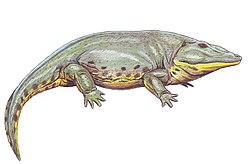| Lueders Formation | |
|---|---|
| Stratigraphic range: Early Permian | |
 Exposure in Wilbarger County, Texas (1908). | |
| Type | Geological formation |
| Unit of | Albany Group |
| Sub-units |
|
| Underlies | Clear Fork Group [1] |
| Overlies | Talpa Formation [1] |
| Thickness | 50 to 70 feet [1] |
| Lithology | |
| Primary | Interbedded shale & limestone [1] |
| Location | |
| Region | Texas |
| Country | United States |
| Type section | |
| Named for | Lueders, Texas |
The Lueders Formation is a geologic formation in Texas. It is the top formation of the Albany Group and preserves fossils dating back to the Permian period. [1]
Contents
- Description
- Paleogeography
- Depositional environment
- Fossil content
- Amphibians
- Fish
- Synapsids
- Invertebrates
- Plants
- See also
- References
















